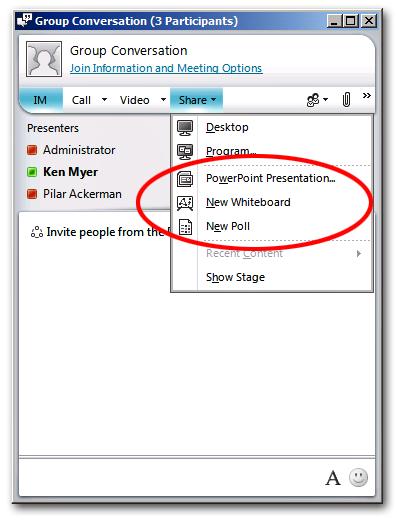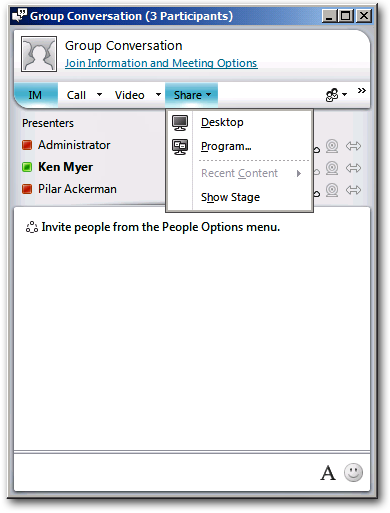Conferencing Policy Settings: EnableDataCollaboration
This article is part of the series An In-Depth Guide to Conferencing Policy Settings.
Parameter/Property Name |
Allowed Values |
EnableDataCollaboration
This is a per-organizer setting. |
· TRUE: Users can create whiteboards and polls, or share PowerPoint slides. This is the default value. · FALSE: Users cannot create whiteboards and polls, or share PowerPoint slides. |
Lync Server Control Panel Equivalent Setting: Data collaboration
So what exactly does the EnableDataCollaboration setting (a parameter/property found in every good conferencing policy) allow you to do? Why that's easy: it allows you to … uh … you know, enable … data collaboration ….
OK, we admit it: until we started looking more deeply into conferencing policies we really weren't sure what the EnableDataCollaboration setting did. But now we know. If data collaboration is enabled in your conferencing policy then you (and anyone else who participates in a meeting that you organized) will have the following three capabilities at your disposal: PowerPoint Presentation, New Whiteboard, and New Poll.
In other words, you'll be allowed to show a PowerPoint slide presentation, you'll be allowed to create a new whiteboard, and you'll be allowed to create a new poll.
And what if your conferencing policy doesn't allow data collaboration? Then you won't have any of those capabilities available to you:
That's what we said: bummer.
Either way, data collaboration is managed by using the aptly-named EnableDataCollaboration property. Want to allow PowerPoint, whiteboards, and polls in a conferencing policy? Then use a command like this one:
Set-CsConferencingPolicy –Identity global –EnableDataCollaboration $True
What's that? You say you don't want to allow PowerPoint, whiteboards, and polls in a conferencing policy? Then use a command like this one instead:
Set-CsConferencingPolicy –Identity global –EnableDataCollaboration $False
So what does it mean to set the EnableDataCollaboration property to True (or to False)? To answer that, let's first note that this property applies to the organizer of a meeting (and thus, by extension, to everyone who participates in that meeting). Consider an organization with two users and two conferencing policies:
User |
Conferencing Policy |
EnableDataCollaboration |
Pilar Ackerman |
global |
False |
Ken Myer |
RedmondConferencingPolicy |
True |
If Pilar Ackerman organizes a meeting no one in that meeting will be able to use PowerPoint, whiteboards, and polls; that's because her conferencing policy prohibits data collaboration. That's not the case with Ken Myer, however. Ken's conferencing policy allows data collaboration; because of that, anyone who joins a meeting organized by Ken Myer will be able to use PowerPoint, whiteboards, and polls.
And yes, that includes Pilar and anyone else whose conferencing policy prohibits data collaboration. When it comes to data collaboration, the only policy that matters is the policy assigned to the meeting organizer.
A couple of quick notes here. Suppose you have no problems with whiteboards or PowerPoint presentations, but you don't like polls. In that case, use the AllowPolls property to disable the creation of new polls while still allowing PowerPoint presentations and whiteboards. Likewise you can disable whiteboards (and only whiteboards) by using the AllowAnnotations property. Or use both properties to get rid of polls and whiteboards, leaving only PowerPoint presentations.
So then how do you get rid of just PowerPoint presentations? Well, you can't: there's no individual setting that applies just to PowerPoint. If you disable the use of PowerPoint you have no choice but to also disable the use of polls and whiteboards.
Go figure, eh?


